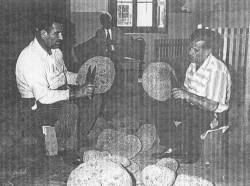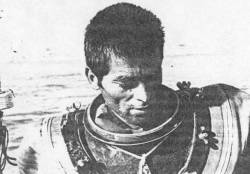KALYMNOS--The young girls of Kalymnos sing their song of farewell, the
wives and mothers weep as the diving boats exit the harbor in slow formation, flags flapping in the breeze, newly painted gunwales gleaming
in the bright Aegean sunlight. And the whole of the ancient harbor resounds with the peal of church bells, and with shouts, cries and sobs:
"Goodby...goodby." "Kalo taxidi...good journey!"
It is six days after Easter. Fifteen caiques are putting out to sea, bound for the far corners of the Aegean. Each boat carries from 12 to 20 men--the famed sphoungarades (sponge divers) of Kalymnos. They will stay away for seven months, risking death or paralysis to tear sponges from the bottom of the sea.
Kalymnos, a Greek
island 10 miles long and five miles wide, has always
been synonymous with sponges. They are what the island used to live on,
before the twin onslaughts of synthetic sponges and mass tourism changed
all that. The former reduced the world- wide demand for natural sponges;
the latter made it unnecessary for most of the islanders to go down to
sea for a living.

With all that, a few hardy captains and crew still follow the traditional
Kalymnian way, if only because diving for sponges is in their blood. It
also helps that certain industrial processes require natural sponges--and
that many people know that no synthetic sponge can come close to matching
the strength and resiliency of the real thing.
There are three kinds
of sponge divers. The skafendros dive wearing a full suit and helmet;
fernezes have the helmet but no suit; and barcas dive exactly as their
ancestors did 3,000 years ago, with held breath.

Today most divers wear a full suit and helmet. The big fear of these "hard
hat" divers is that their air hose might break. If it should, and
if the diver fails to utilize his helmet's safety- valve in time, the
suction of the pipe will strip away his flesh.
What is more commonplace
is nitrogen poisoning, or the "bends." If a diver is stricken
with it--usually because he has stayed down too long and ascended too
rapidly--he can be paralyzed for life. Of the 14,00 inhabitants of Kalymnos,
about 1,500 are victims of the bends.

In previous years, the sponge fleet traveled as far as Libya and Malta
to fish for sponges. Today the divers are restricted to Greek waters.
They leave their beautiful village with its cube- like, quilt-colored
houses dug precariously into the bare flanks of the hills ringing the
harbor and head toward Rhodes and Crete, Santorini and Tilos.
For seven months it will be the same. The day will begin at 5.30 a.m.
Two hours later the first diver will go over the side. Each diver makes
three or four dives a day, staying down from 20 minutes to an hour each
time.
After ascending,
the diver empties his bag of sponges on the deck. The
coral-encrusted black blobs are then trampled on with bare feet and rinsed
in sea water. After being pierced with a thick steel needle, threaded
on a length of rope and tossed over the side to be washed further by the
sea, they are scrubbed and trimmed, and ultimately put in sacks to be
delivered to Kalymnos.
And so it goes. Monotony,
exhaustion, humiliation, frayed tempers,
loneliness--this is what the divers endure. "No ordeal is more terrifying
than that of the sponge divers and no labor more arduous for men,"
wrote Oppian in the third century A.D. It is no different today.